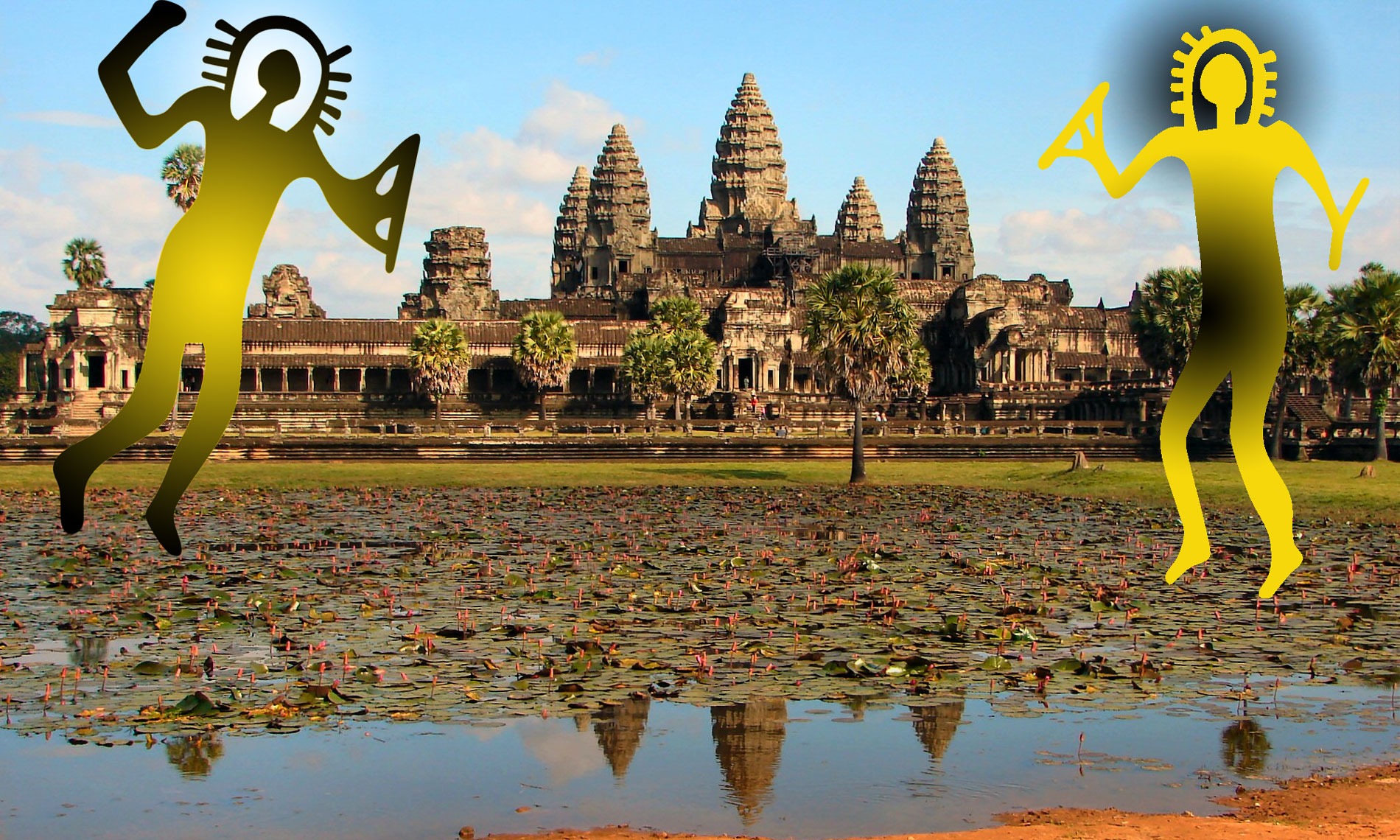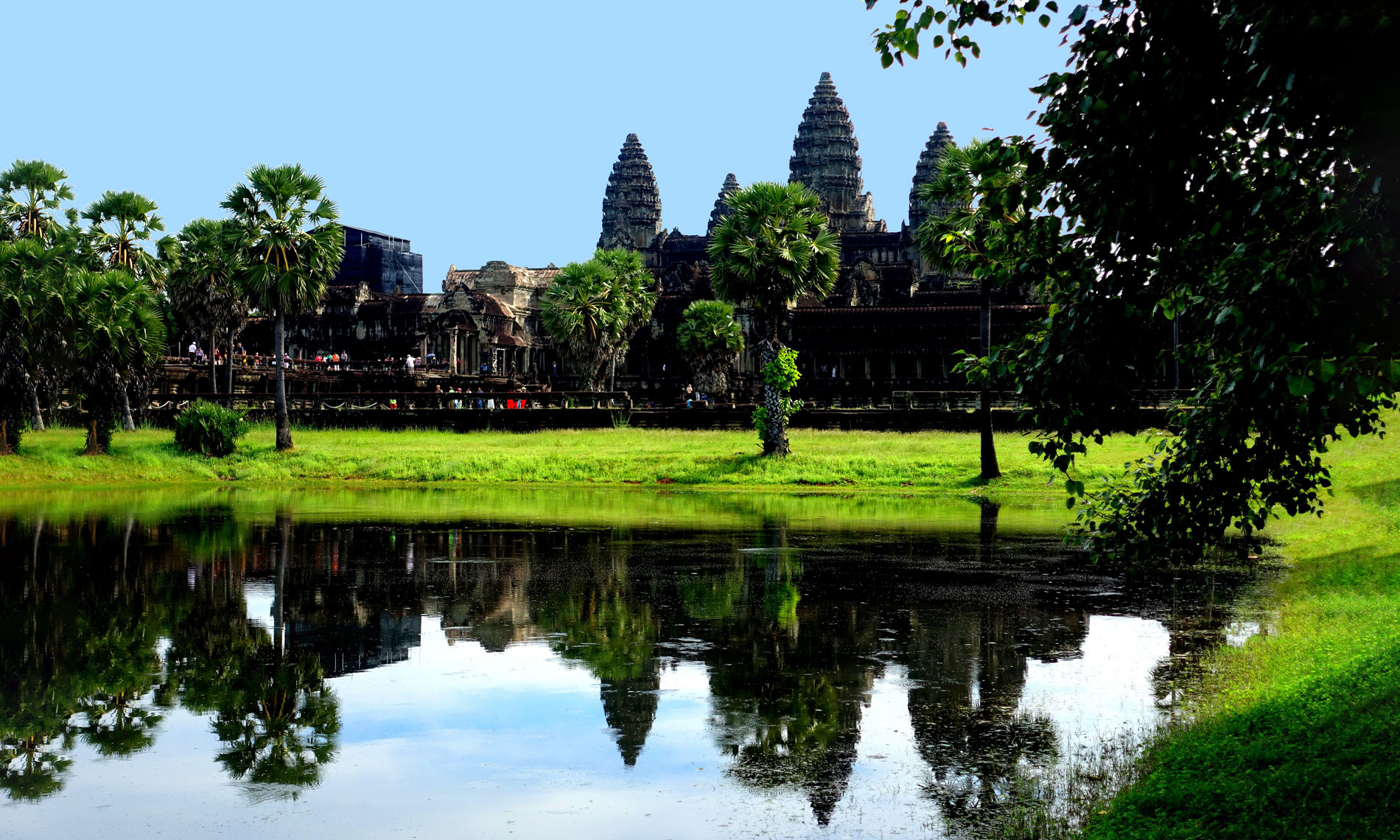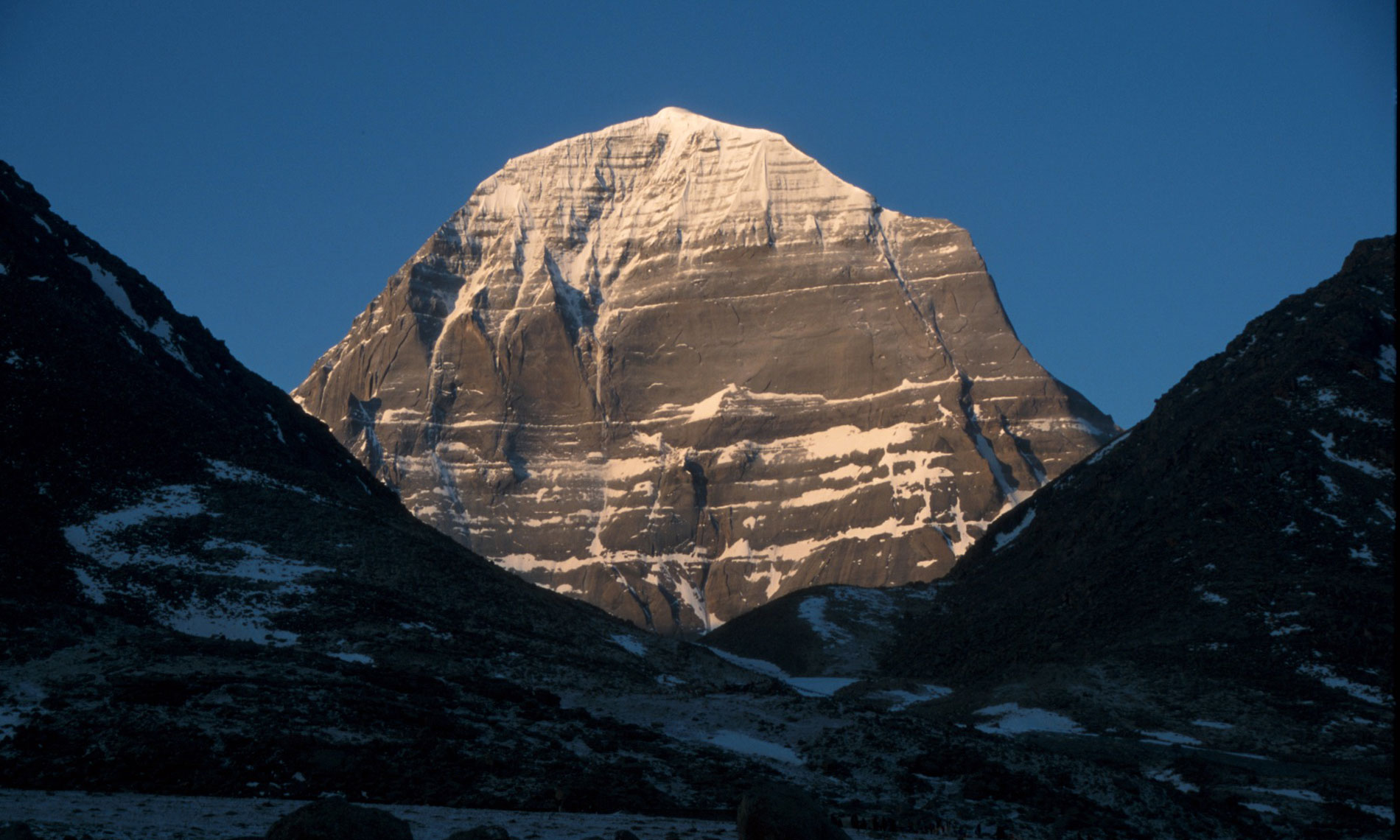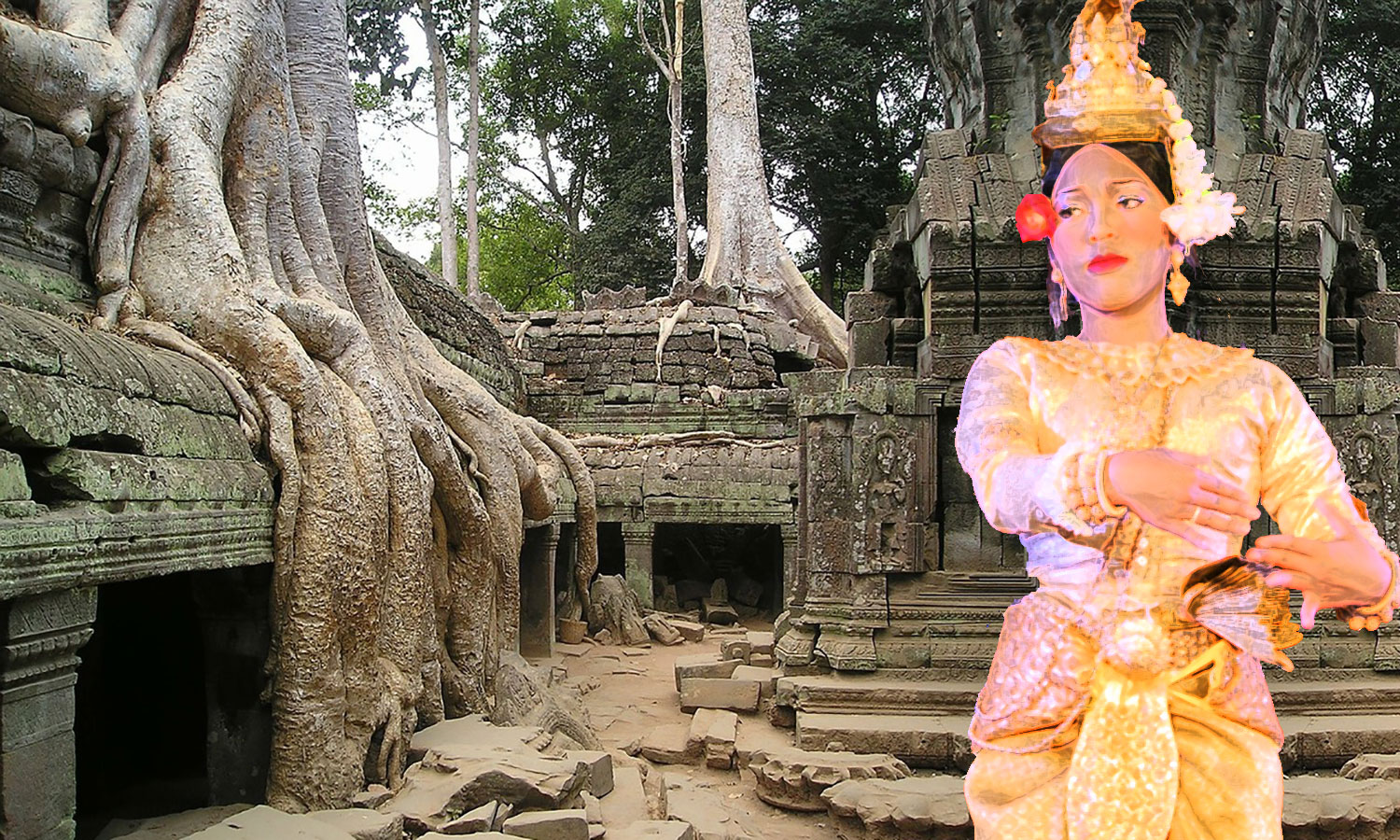
Dating from the 9th to the 12th centuries, the city of Angkor, capital of the ancient Khmer Empire, is one of the largest medieval structures in the world. The Cambodian jungle has invaded a part of the site, but we know that the urban center extended over 400 km2 and the total surface reached 3 000 km2, ten times more than imagined.
Yet the mysteries of Angkor are not limited to architectural prowess. It reveals several enigmas which I propose to make a quick catalog.
The hydraulic enigma
The gigantic city is characterized by a colossal irrigation system with pools, moats and innumerable canals, which classify the Khmer Empire among the most prestigious hydraulic civilizations of the past.
The temples are built on the sand and without foundations. How are they still standing? By a marvel of engineering. Khmer hydraulic engineers have planned very wide and deep moats. Rainwater filled them, it moistures sand – and wet sand became harder than stone. In this way they were able to build buildings of colossal weight without any foundation, such as the huge temple of Angkor Wat. This knowledge did not fall from the sky. Maybe it did? In any case, this is what the myths affirm.See further
The amount of water is proportionate to the size of the buildings. On smaller temples, moats are smaller. A complex network of canals and reservoirs carried water from the great Tonle Sap Lake, itself fueled by the Mekong, so that drought never compromised the strength of temples and palaces. Where do these hydraulic knowledge come from in the middle ages? I see an indisputable development index: in most cases, a hydraulic system is linked to electricity, automation, mechanics or special machines.
The language of the birds flies to the aid of the decryption, as often see in my posts. Linked to electricity? The temple of Angkor Wat? … pronounce watt … Does the Khmer Empire could have been technological? Or inspired by a civilization that was?
“Located along the Gulf of Thailand, the region has in its center a Great Lake (the Tonle Sap), regulator of the Mekong River, which is transformed into a real small inland sea in the rainy season, an inexhaustible pool! local authorities will therefore have to become experts in hydraulics: over the centuries, dike and canal systems, ever more sophisticated, will allow the creation of “barays” (basins) and the development of rice growing. the creation of a powerful kingdom: only one builder is missing …” (source)
The expert enigma
Let us point out an error too often made: the author supposes that irrigation has improved over the centuries. But no. Neither irrigation, nor agriculture, nor astronomy, nothing gets better. Especially not the lessons. Everything deteriorates, physics teaches us that, but most of the time we ignore it. This is the myth of constant progress that is often sacrificed. Whether you are a scholar or a scholar, you always assume that everything is better than before. The old people say the opposite, but who still listens to them?
On the great Tonle Sap Lake, it is incorrect to say that the irrigation system was not more and more perfected. On the contrary. The mastery of hydraulics is greater at the origin than it has become over the centuries. This tends to show that the original knowledge was transmitted to the Khmers by qualified experts. Who ?

Chefs. Giants. Pilots. Competent. Qualified. Scientists – engineers, builders, hydraulics – professionals fallen from the sky. It is they who in secret prepared the advent of a human prince. This builder is only a divine puppet, a facade, an avatar. He is piloted by more powerful than him.
Like all of us, yes, you are right. This is why we can look at official history as a web without a soul, and revive it. The past can be reborn better and better for us. The Khmers had prepared the advent of a great prince, of an emperor. There will be several: Suryavarman 1st and his successor Suryavarman II, builder of Angkor Wat, are the main ones. The kingdom becomes an empire.
Wikipedia swings a good info: The two Suryavarman are sometimes referred to as “sun king” – Surya is a Sanskrit term meaning “sun”. These two emperors are therefore also Sons of the Sun, children of Hyperborea, undoubtedly born from a cross between a woman and a god. Which suddenly clears up many enigmas, but which poses many others.
The Khmer Empire was born suddenly. It has spread at an inexplicable speed: all of Southeast Asia will be conquered in 22 years. How? ‘Or’ What ? By iron, say archaeologists and historians. But where did this iron come from?
The iron enigma
Indeed, iron was rare, if not totally absent in the Khmer empire. Yet it served not only to manufacture the weapons of conquest, but also architectural elements. When we talk about Ankor, we think of the main temple, Angkor Wat. But given its size, the imperial city includes many buildings, temples, palaces, stables … The countless blocks of stone needed for this gigantic construction site were assembled without mortar, in the Cyclopean way. Yet they are not as huge as the Cyclopean blocks of Tiahuanaco, Sacsayhuaman, Puma Punku, or Baalbek.
Having neither mortar nor the advantage of weight to hold them in place, they are securely tied to each other with iron staples. This Cyclopean technique is found in many cyclopean walls around the world. Here, considering the extent of the site, it took hundreds of thousands of staples, even millions! A thorny question arises immediately: where did the builders find the iron to forge them?
The temple of Angkor and its cupolas in the shape of vimana are perhaps an answer … These ancient flying machines would have defied the constraint of the gravity, which enabled them to lift the heaviest loads and to make them crossing huge distances …
The divine enigma
Archaeologists flounder in semolina.Litteral translation for French patauger dans la semoule, meaning don’t get a bit Historians remain like a two-coin flan.Litteral translation fo French “rester comme deux ronds de flan” meaning “remain speechless, stand stupid” Forget them. Once again, the answer is to be found in mythology. As you will see, it is more eloquent.
By the 2nd century CE,Common Era while in Cambodia King Devunaghar (“protector of the divine lineage”) did not seem to have an heir, Indra, the king of the gods, decided to descend to earth to give a son to the main queen Vong. The boy will be elevated to the court of Khmer rulers until becoming a teenager, Indra invites him to spend a week in his kingdom of heaven. At the end of his stay, and while the young man had expressed his admiration for the wealth he had observed, Indra offers to send him his personal architect – from the union of a mere mortal and of a devi – to build on earth a reproduction of his choice of one of the buildings he could appreciate. Anxious not to arouse the jealousy of the king of the gods by a request too luxurious, the teenager is content to request a copy of the stables of Indra. The architect runs and Angkor Wat comes out of the ground. (source)
For historians who do not believe in the veracity of myths, it does not change anything. But for me, the case is closed. Why King Devunaghar was called Protector of the divine lineage? Because there was a divine lineage to protect. Why God Indra decided to give a son to the main queen? To start a new divine lineage.
The Khmer civilization has benefited from a famous boost from a highly developed civilization, the technology on powerful, that of the Hyperboreans. That of the terraformers of this planet. That of the gods before, who were not gods, but supermen of great size, with almost infinite knowledge.
And the local religion comes to the aid of mythology. Dating back to the 9th century AD, the oldest temples, called mountain temples, pay homage to Mount Meru, the mythical place of the gods. Not so mythical for me! Paradise of Shiva, paradise of the Chinese, this stay of the gods which Westerners call Hyperborea. Why Indra invited the teenager at the Gods place? To teach him. To show him the truth about gods power. It was a divine habit to invite young semi gods or gifted humans at the Gods. See Adapa, Cuchulainn, Rama, Gilgamesh and others.
As I have shown, Hyperborea is not an island beyond the North Pole, of which one would be hard to find traces, but of an island above the North Pole. This is for me an island in the sky. A giant spacecraft, the kind that science fiction calls mothership, like the Star Wars Star of Black … Of course this interpretation was impossible for the humans of antiquity! It remains unacceptable for nowaday morons, while they have seen it in all screens.

The sun enigma
Angkor Wat ប្រាសាទអង្គរវត្ត (Prasat Angkor Wat) is the largest temples of the monumental complex of Angkor in Cambodia. It was built by Suryavarman II in the early twelfth century as a state temple and capital. (source)
Suryavarman II (Khmer: ព្រះបាទ សូរ្យ វរ្ម័ន ទី 2, posthumous name Paramavishnuloka) is king of the Khmer Empire from 1113 to 1150, builder of Angkor Wat, his state temple, which he dedicates to the Hindu god Vishnu. It is the most prestigious royal monument of the site and the masterpiece of the classical Khmer period.
He takes the name of Suryavarman after his accession to the throne. Surya is a Sanskrit term meaning sun and varman is a royal suffix usually translated as shield or protector. This sovereign as well as Suryavarman 1st are sometimes called the sun kings. (source)
The sun kings! My diligent readers will remember who are the Sons of the Sun of antiquity: humans or demi-gods raised and trained on Hyperborea. Phaeton, son of Apollo of Hyperborea, will also be named son of the Sun because he wanted to fly the mother ship, apparently causing some damage. Atlas, son of Poseidon, did not succeed much … But our civilization has totally forgotten that, because the Greeks, transmitters of the previous data, have understood nothing of history. We had the great mistake of trusting them, and we took this title of son of the sun for a symbolic name referring only to the greatness of those who wear it. Hence the egotistical appropriation made by the tyrant of Louis XIV, who called himself the sun king. Ego, when you hold us …
The time enigma
In the 12th century AD, Suryavarman I began work on the Angkor complex. In particular, he worked on the great basin, showing that the Khmer society of that time is to be classed without hesitation in the hydraulic civilizations. (source) Yet most hydraulic civilizations are much earlier than this period.
In America, Europe or elsewhere, Cyclopean monuments are older. Archeology dates from the beginning of our era, and for my part I think much earlier than this period. I note, however, that the origin of the city of Angkor is distant: we find traces of construction that date from the end of the previous era, or the very beginning of ours.
The gods of the past have intervened many times in human history. They have manifested themselves in many countries. They were the guardians of this humanity, openly or discreetly, playing the role of protectors or tyrants, according to the times or circumstances. It’s a safe bet that they will come back, and this prospect does not enchant me.
The decline enigma
From the 14th century BCE, the Khmer empire crumbled. It is attacked at its borders by neighboring peoples, jealous of its magnificence. Its capital Angkor begins a phase of decline that will lead to its abandonment in 1432. Why? We do not know anything.
“The reasons for the decline of this empire and the abandonment of the Angkor site are still unclear, but the likelihood of an ecological catastrophe is very high.An international study, conducted jointly by the University of Sydney, French School of the Far East and the Apsara authority of the Cambodian government, seem to have established a correlation with climate change.
A long period of drought would have destroyed the economy and life in Angkor. Indeed, the Khmer had developed in this city large networks of canals and reservoirs, used both for travel and trade and for irrigation crops. In the face of water scarcity, this infrastructure has fallen into disuse and the inhabitants have left the city. “(Source)
Let me doubt it. If a drought had continued, so intense that the rice fields had dried up, so would the canals and moats of the temples. Without the moat water, as we have seen above, the temples built without foundation would have sunk into the dry sand. The fact that we can still admire them today proves that it was nothing.
Moreover, if the hydraulic network had dried up, the attraction of the magnificent capital would have disappeared, and with it the greed of the neighboring peoples. Who wants to conquer ruins?
In light of what has just been explained, everyone will be able to make the same conclusion. The Khmer civilization collapsed for the simple reason that its divine guardians stopped supporting it. The wind of history blows where the gods want it. Genius is incarnated sometimes here, sometimes there, according to the semi-divine incarnations and emissaries of Hyperborea.

The last enigma
Ultimate exhibit: the name of Angk / or. We can recognize the phoneme Ahn, Ann, Enn which comes from the language of the origins and means the ancestor, the ancient ones, the former gods. Phoneme which has been declined in many modern languages or tongues, and is also found in ancient Egyptian in the form ankh, the cross of life, symbol of all-powerful gods, and whose similarity with Angk is even more striking.
We also identify the final phoneme Or, which is also declined in Ur, Our or Er, and which indicates the origin in many languages, meaning prier, former, and first of all the origin of the ancestors in question, ie our origin and their, the planet Ur, in the stellar system of Alcor, located in the constellation Ursa Major. Help yourself, it’s happy hour!
Sacred Hydrology
- Ancient Hydraulic Civilizations
- Wonderful City of Ys
- Solomon’s Magic Bath
- Cenotes And Sacred Wells
- Tipon, Eden of the Andes
- The Sayhuite Monolith
- The Angkor Enigmas
- Water Of Madness
- Water of Youth
- The Vital Water Of Marcel Violet


